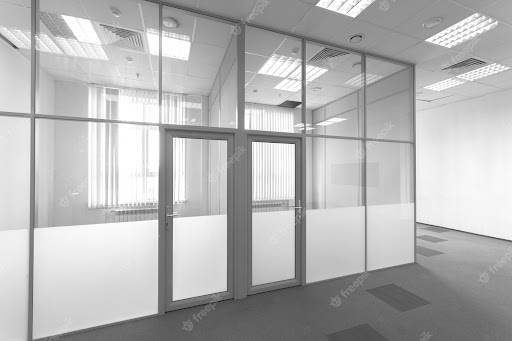Glass partition walls have become an increasingly popular choice for commercial, residential, and industrial spaces. They provide a modern and sleek look while offering various practical benefits such as enhancing natural light, creating a sense of openness, and improving acoustics. This article will explore the different types of glass partition systems, recent innovations in the field, top trends in glass partition design, and how to choose the right system for your space.
Types of Glass Partition Systems
There are several types of glass partition systems available in the market, each with its unique features and benefits. Understanding the differences between these systems can help you make an informed decision when designing your space.
Frameless Glass Partition Walls
Frameless glass partition walls are a popular choice for their minimalistic and modern appearance. They are made from tempered or laminated glass, which ensures strength and durability. These systems typically use a minimal amount of hardware and are held in place by floor and ceiling channels, creating a seamless and clean look. Frameless glass partition walls are ideal for creating open and bright spaces while maintaining a sense of privacy.
Framed Glass Partition Walls
Framed glass partition walls use aluminum or steel frames to provide additional structural support to the glass panels. These systems can be customized with various finishes and colors to match the overall design of the space. Framed glass partition walls offer enhanced stability and can accommodate additional features such as integrated blinds, doors, and cable management systems.
Sliding Glass Partition Walls
Sliding glass partition walls are a versatile and space-saving option, as they can be easily retracted or moved to adapt to different layouts and requirements. These systems can be either frameless or framed, depending on the desired aesthetic and structural needs. Sliding glass partition walls are ideal for dividing large spaces, creating flexible work areas, or providing temporary privacy.
Recent Innovations in Glass Partition Systems
The glass partition industry has seen significant advancements in recent years, with innovative technologies and materials being introduced to improve functionality, aesthetics, and sustainability.
Smart Glass Technology
Smart glass, also known as switchable glass or electrochromic glass, allows users to control the level of transparency, privacy, and light transmission of the glass panels. This is achieved by applying an electrical current to the glass, which changes its opacity. Smart glass technology can be integrated into various types of glass partition systems, offering a customizable and dynamic solution for privacy and light control.
Acoustic Glass Partition Walls
Improving acoustics is a crucial consideration for many spaces, particularly in offices and educational facilities. Acoustic glass partition walls are designed to provide enhanced sound insulation while maintaining the visual benefits of traditional glass partitions. These systems typically feature double-glazed glass panels or incorporate specialized interlayers, such as acoustic polyvinyl butyral (PVB), to reduce sound transmission.
Sustainable Glass Partition Systems
Sustainability is a growing concern in the construction and design industry, and glass partition systems are no exception. Manufacturers are now focusing on developing eco-friendly systems that use recycled materials, incorporate energy-efficient features, and have a reduced environmental impact. Examples include using low-emissivity (Low-E) glass coatings to minimize heat loss and incorporating photovoltaic cells into the glass panels to generate electricity.
Top Trends in Glass Partition Design
As glass partition walls continue to grow in popularity, various design trends have emerged that cater to different aesthetics and functional requirements.
Industrial Chic
The industrial chic trend incorporates raw materials, such as exposed brick and metal, to create a rugged and urban aesthetic. Glass partition walls can be used to complement this style, with black-framed systems being particularly popular to create a bold contrast with the surrounding materials.
Minimalist Design
Minimalism emphasizes simplicity, clean lines, and uncluttered spaces. Frameless glass partition walls are the perfect choice for this design trend, as they create a seamless and transparent look that allows light to flow freely through the space.
Biophilic Design
Biophilic design focuses on incorporating elements of nature into the built environment to promote wellbeing and productivity. Glass partition walls can help achieve this by allowing natural light to penetrate deep into the space, reducing reliance on artificial lighting, and creating a connection with the outdoors. Integrating greenery, such as living walls or planters, into the glass partition systems can further enhance the biophilic design.
Choosing the Right Glass Partition System for Your Space
Selecting the right glass partition system for your space requires careful consideration of various factors, including aesthetics, functionality, and budget. Here are some key aspects to consider when making your decision:
- Design and Aesthetic Preferences: Consider the overall design of your space and the desired aesthetic when choosing between frameless, framed, or sliding glass partition walls. Each system offers a unique look and can be customized to match the design of your space.
- Functional Requirements: Determine the specific requirements of your space, such as enhanced acoustics, privacy, or flexibility. This will help you identify the most suitable glass partition system and any additional features, such as smart glass technology or integrated blinds.
- Budget: Glass partition walls can vary significantly in price depending on the type, materials, and features. Establish a budget to help narrow down your options and ensure you select a system that meets your requirements without breaking the bank.
In conclusion, glass partition walls offer a versatile and stylish solution for dividing spaces while maintaining a sense of openness and natural light. With numerous types, innovations, and design trends available, it’s essential to carefully consider your specific needs and preferences when choosing the right system for your space.






